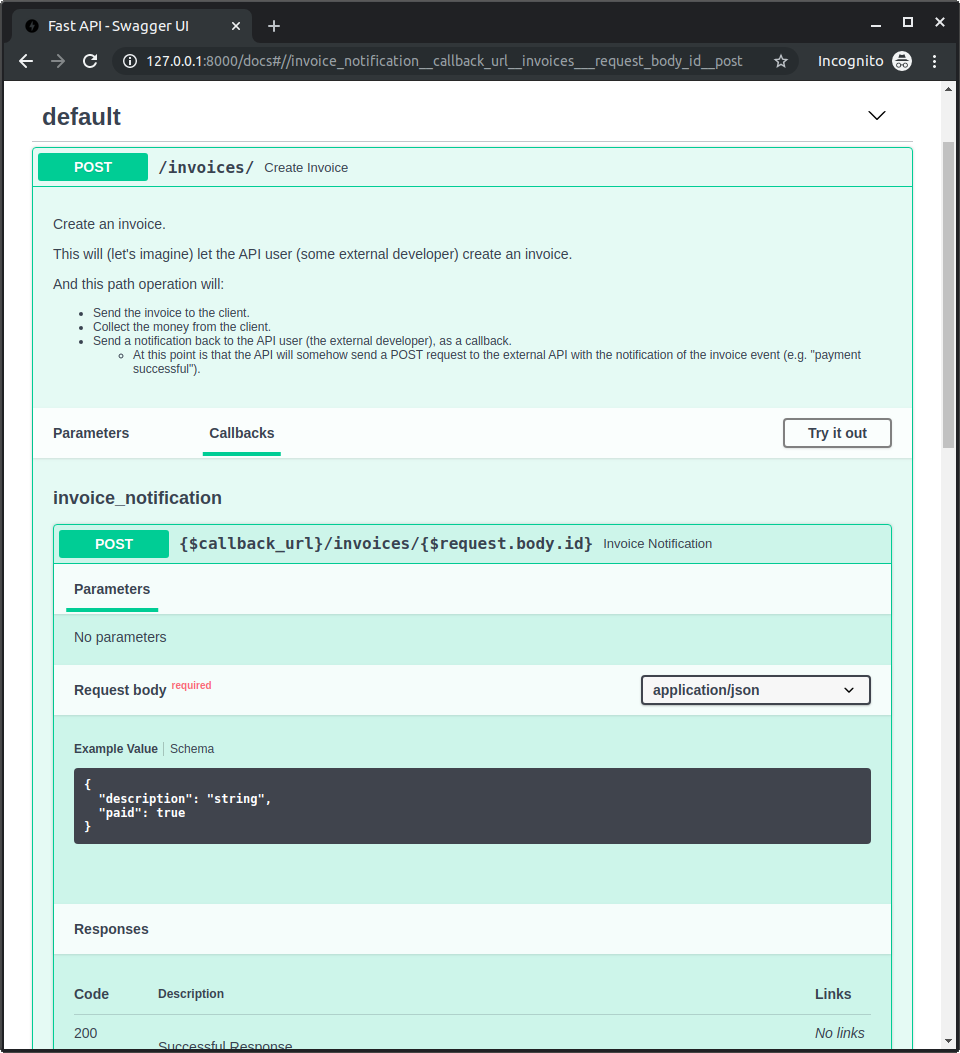OpenAPI 回调¶
你可以创建一个带 *路径操作* 的 API,它可能会触发对由其他人(很可能是将 *使用* 你的 API 的同一开发者)创建的 *外部 API* 的请求。
当你的 API 应用程序调用 *外部 API* 时发生的过程称为“回调”。因为外部开发者编写的软件向你的 API 发送请求,然后你的 API *回调*,向一个 *外部 API*(很可能是由同一开发者创建的)发送请求。
在这种情况下,你可能希望记录该外部 API *应该* 是什么样子。它应该有什么 *路径操作*,它应该期望什么请求体,它应该返回什么响应等等。
带回调的应用程序¶
让我们通过一个例子来看这一切。
想象你开发一个允许创建发票的应用程序。
这些发票将包含 `id`、`title`(可选)、`customer` 和 `total`。
你的 API 用户(外部开发者)将通过 POST 请求在你的 API 中创建发票。
然后你的 API 将(让我们想象)
- 将发票发送给外部开发者的某些客户。
- 收款。
- 向 API 用户(外部开发者)发送通知。
- 这将通过向该外部开发者提供的某个 *外部 API* 发送 POST 请求(从 *你的 API*)来完成(这就是“回调”)。
正常的 FastAPI 应用程序¶
让我们先看看在添加回调之前,正常的 API 应用程序会是什么样子。
它将有一个 *路径操作*,接收一个 `Invoice` 请求体,以及一个查询参数 `callback_url`,其中包含回调的 URL。
这部分很正常,大部分代码你可能已经很熟悉了
from typing import Union
from fastapi import APIRouter, FastAPI
from pydantic import BaseModel, HttpUrl
app = FastAPI()
class Invoice(BaseModel):
id: str
title: Union[str, None] = None
customer: str
total: float
class InvoiceEvent(BaseModel):
description: str
paid: bool
class InvoiceEventReceived(BaseModel):
ok: bool
invoices_callback_router = APIRouter()
@invoices_callback_router.post(
"{$callback_url}/invoices/{$request.body.id}", response_model=InvoiceEventReceived
)
def invoice_notification(body: InvoiceEvent):
pass
@app.post("/invoices/", callbacks=invoices_callback_router.routes)
def create_invoice(invoice: Invoice, callback_url: Union[HttpUrl, None] = None):
"""
Create an invoice.
This will (let's imagine) let the API user (some external developer) create an
invoice.
And this path operation will:
* Send the invoice to the client.
* Collect the money from the client.
* Send a notification back to the API user (the external developer), as a callback.
* At this point is that the API will somehow send a POST request to the
external API with the notification of the invoice event
(e.g. "payment successful").
"""
# Send the invoice, collect the money, send the notification (the callback)
return {"msg": "Invoice received"}
提示
callback_url 查询参数使用了 Pydantic Url 类型。
唯一的新东西是 `callbacks=invoices_callback_router.routes` 作为 *路径操作装饰器* 的参数。我们接下来会看到那是什么。
文档化回调¶
实际的回调代码将很大程度上取决于你自己的 API 应用程序。
它也可能在不同应用程序之间差异很大。
它可能只有一两行代码,比如
callback_url = "https://example.com/api/v1/invoices/events/"
httpx.post(callback_url, json={"description": "Invoice paid", "paid": True})
但回调中最重要的部分可能是确保你的 API 用户(外部开发者)根据 *你的 API* 将在回调请求体中发送的数据等正确实现 *外部 API*。
所以,我们接下来要做的是添加代码来记录该 *外部 API* 应该是什么样子,以便接收来自 *你的 API* 的回调。
该文档将显示在你的 API 的 `/docs` 处的 Swagger UI 中,它将让外部开发者知道如何构建 *外部 API*。
这个例子没有实现回调本身(那可能只是一行代码),只实现了文档部分。
编写回调文档代码¶
这段代码不会在你的应用程序中执行,我们只需要它来 *文档化* 该 *外部 API* 应该是什么样子。
但是,你已经知道如何使用 FastAPI 轻松为 API 创建自动文档。
所以我们将使用相同的知识来文档化 *外部 API* 应该是什么样子……通过创建外部 API 应该实现的 *路径操作*(也就是你的 API 将调用的那些)。
提示
在编写文档化回调的代码时,想象你是那个 *外部开发者* 可能会很有用。并且你当前正在实现 *外部 API*,而不是 *你的 API*。
暂时采纳这种观点(*外部开发者* 的观点)可以帮助你更容易地了解该 *外部 API* 的参数、请求体 Pydantic 模型、响应等应该放在哪里。
创建回调 APIRouter¶
首先创建一个新的 APIRouter,它将包含一个或多个回调。
from typing import Union
from fastapi import APIRouter, FastAPI
from pydantic import BaseModel, HttpUrl
app = FastAPI()
class Invoice(BaseModel):
id: str
title: Union[str, None] = None
customer: str
total: float
class InvoiceEvent(BaseModel):
description: str
paid: bool
class InvoiceEventReceived(BaseModel):
ok: bool
invoices_callback_router = APIRouter()
@invoices_callback_router.post(
"{$callback_url}/invoices/{$request.body.id}", response_model=InvoiceEventReceived
)
def invoice_notification(body: InvoiceEvent):
pass
@app.post("/invoices/", callbacks=invoices_callback_router.routes)
def create_invoice(invoice: Invoice, callback_url: Union[HttpUrl, None] = None):
"""
Create an invoice.
This will (let's imagine) let the API user (some external developer) create an
invoice.
And this path operation will:
* Send the invoice to the client.
* Collect the money from the client.
* Send a notification back to the API user (the external developer), as a callback.
* At this point is that the API will somehow send a POST request to the
external API with the notification of the invoice event
(e.g. "payment successful").
"""
# Send the invoice, collect the money, send the notification (the callback)
return {"msg": "Invoice received"}
创建回调 *路径操作*¶
要创建回调 *路径操作*,使用你上面创建的同一个 APIRouter。
它看起来应该就像一个正常的 FastAPI *路径操作*
- 它可能应该有一个它将接收的请求体的声明,例如 `body: InvoiceEvent`。
- 它还可以有一个它应该返回的响应的声明,例如 `response_model=InvoiceEventReceived`。
from typing import Union
from fastapi import APIRouter, FastAPI
from pydantic import BaseModel, HttpUrl
app = FastAPI()
class Invoice(BaseModel):
id: str
title: Union[str, None] = None
customer: str
total: float
class InvoiceEvent(BaseModel):
description: str
paid: bool
class InvoiceEventReceived(BaseModel):
ok: bool
invoices_callback_router = APIRouter()
@invoices_callback_router.post(
"{$callback_url}/invoices/{$request.body.id}", response_model=InvoiceEventReceived
)
def invoice_notification(body: InvoiceEvent):
pass
@app.post("/invoices/", callbacks=invoices_callback_router.routes)
def create_invoice(invoice: Invoice, callback_url: Union[HttpUrl, None] = None):
"""
Create an invoice.
This will (let's imagine) let the API user (some external developer) create an
invoice.
And this path operation will:
* Send the invoice to the client.
* Collect the money from the client.
* Send a notification back to the API user (the external developer), as a callback.
* At this point is that the API will somehow send a POST request to the
external API with the notification of the invoice event
(e.g. "payment successful").
"""
# Send the invoice, collect the money, send the notification (the callback)
return {"msg": "Invoice received"}
与正常的 *路径操作* 有 2 个主要区别
- 它不需要有任何实际代码,因为你的应用程序永远不会调用这段代码。它仅用于文档化 *外部 API*。因此,该函数可以只包含 `pass`。
- *路径* 可以包含一个 OpenAPI 3 表达式(详见下文),其中可以使用包含参数的变量以及发送到 *你的 API* 的原始请求的部分内容。
回调路径表达式¶
回调 *路径* 可以包含一个 OpenAPI 3 表达式,其中可以包含发送到 *你的 API* 的原始请求的部分内容。
在这种情况下,它是 `str`
"{$callback_url}/invoices/{$request.body.id}"
因此,如果你的 API 用户(外部开发者)向 *你的 API* 发送请求至
https://yourapi.com/invoices/?callback_url=https://www.external.org/events
并带有以下 JSON 请求体
{
"id": "2expen51ve",
"customer": "Mr. Richie Rich",
"total": "9999"
}
那么 *你的 API* 将处理发票,并在稍后的某个时候,向 `callback_url`(*外部 API*)发送回调请求
https://www.external.org/events/invoices/2expen51ve
并带有类似如下的 JSON 请求体
{
"description": "Payment celebration",
"paid": true
}
并且它会期望从该 *外部 API* 获得一个类似如下 JSON 请求体的响应
{
"ok": true
}
提示
请注意,所使用的回调 URL 包含了在 `callback_url` 中作为查询参数接收的 URL (`https://www.external.org/events`),以及来自 JSON 请求体内部的发票 `id` (`2expen51ve`)。
添加回调路由器¶
此时,你已经在上面创建的回调路由器中拥有了所需的回调 *路径操作*(即 *外部开发者* 应该在 *外部 API* 中实现的那些)。
现在,使用 *你的 API 的路径操作装饰器* 中的 `callbacks` 参数,传递该回调路由器的 `.routes` 属性(这实际上只是一个路由/*路径操作* 的 `list`)
from typing import Union
from fastapi import APIRouter, FastAPI
from pydantic import BaseModel, HttpUrl
app = FastAPI()
class Invoice(BaseModel):
id: str
title: Union[str, None] = None
customer: str
total: float
class InvoiceEvent(BaseModel):
description: str
paid: bool
class InvoiceEventReceived(BaseModel):
ok: bool
invoices_callback_router = APIRouter()
@invoices_callback_router.post(
"{$callback_url}/invoices/{$request.body.id}", response_model=InvoiceEventReceived
)
def invoice_notification(body: InvoiceEvent):
pass
@app.post("/invoices/", callbacks=invoices_callback_router.routes)
def create_invoice(invoice: Invoice, callback_url: Union[HttpUrl, None] = None):
"""
Create an invoice.
This will (let's imagine) let the API user (some external developer) create an
invoice.
And this path operation will:
* Send the invoice to the client.
* Collect the money from the client.
* Send a notification back to the API user (the external developer), as a callback.
* At this point is that the API will somehow send a POST request to the
external API with the notification of the invoice event
(e.g. "payment successful").
"""
# Send the invoice, collect the money, send the notification (the callback)
return {"msg": "Invoice received"}
提示
请注意,你不是将路由器本身 (`invoices_callback_router`) 传递给 `callback=`,而是传递 `.routes` 属性,例如 `invoices_callback_router.routes`。
检查文档¶
现在你可以启动你的应用程序并访问 http://127.0.0.1:8000/docs。
你将看到你的文档,其中包括你的 *路径操作* 的“回调”部分,该部分显示了 *外部 API* 应该是什么样子
